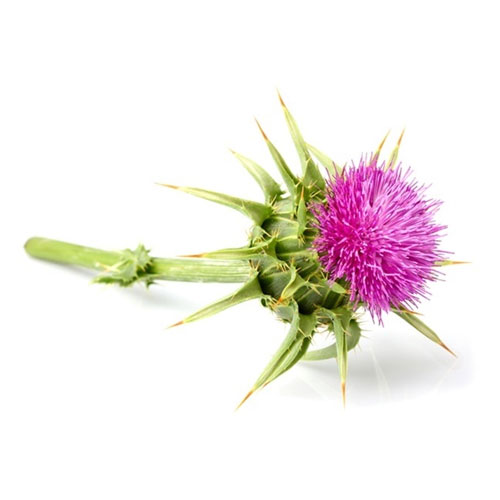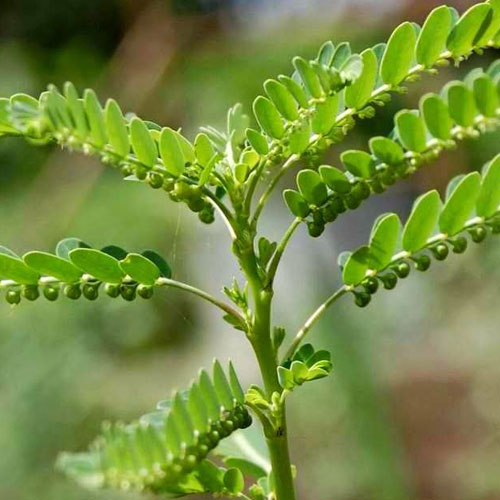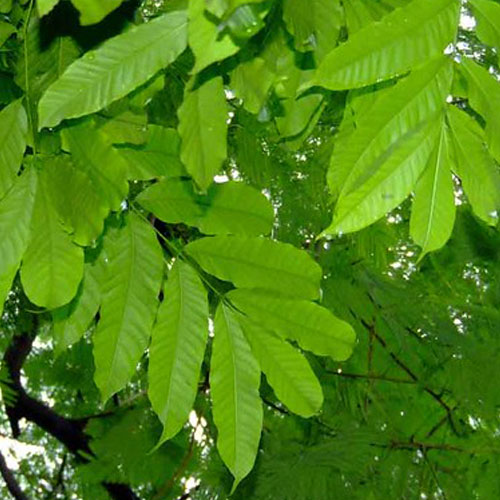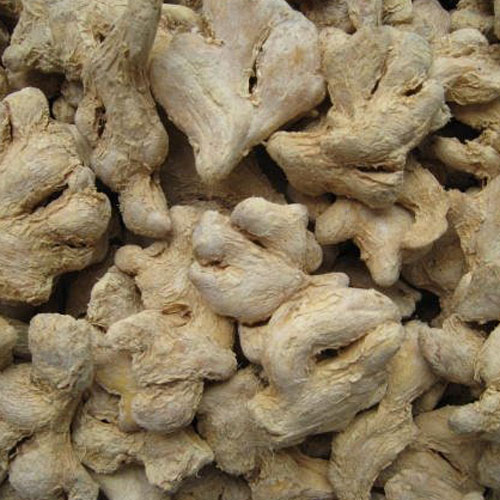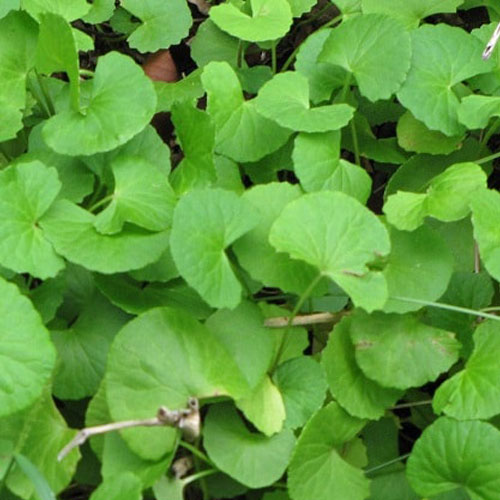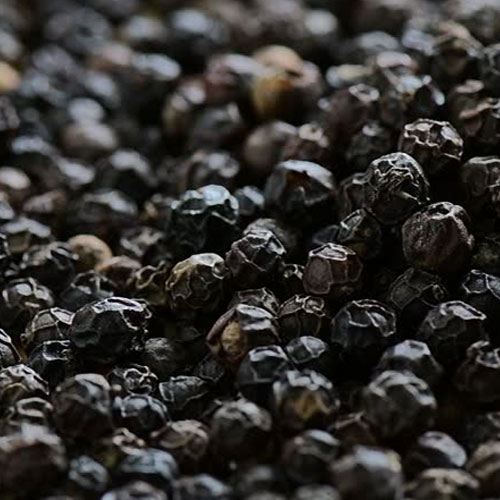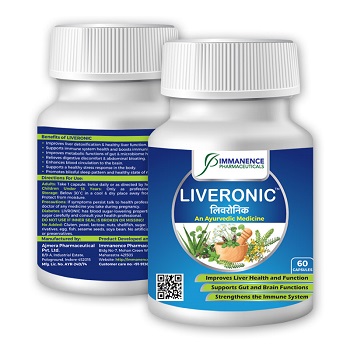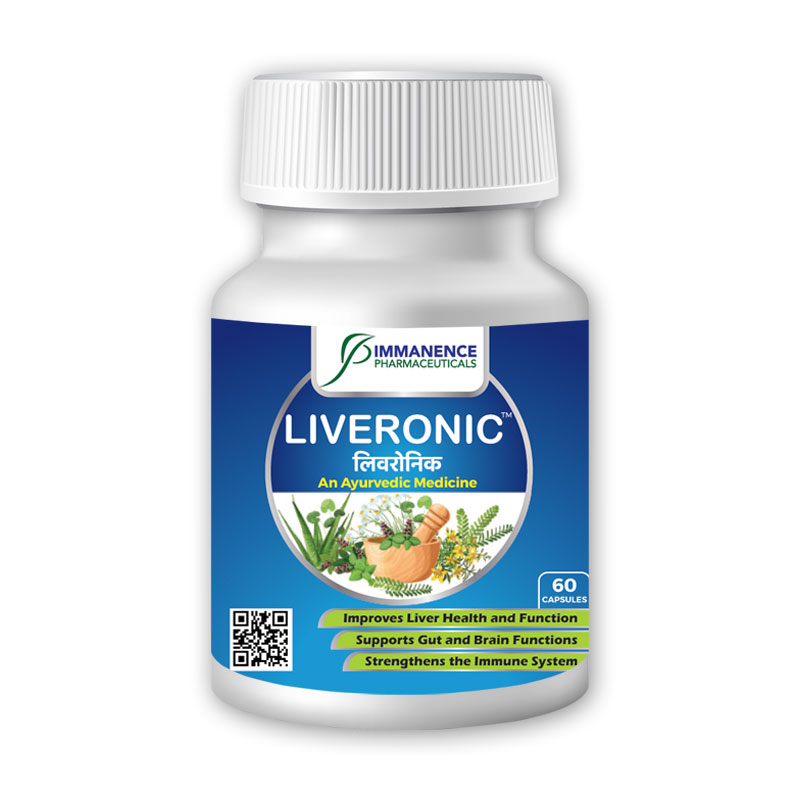Liveronic
- Brand:Liveronic
-
M. R. P. : 799.00
- (INCL. ALL TAXES)
Free Delivery for orders over Rs. 1500/-
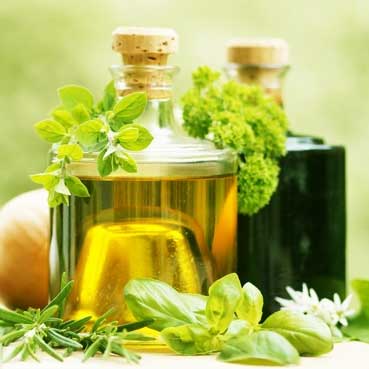
LIVERONIC
LIVERONIC contains a blend of ancient ayurvedic herbs that are formulated based on scientific evidence.
LIVERONIC helps to support the detoxifying capacity of the liver, increase bile output & promote its flow from liver and gallbladder.
It also enhances and supports the body’s immune and gastrointestinal systems.
Ingredients used in LIVERONIC act as antioxidants to help reduce the free radicals and associated damage to the body cells.
Lastly, it helps to maintain the functions of our nervous system and also supports a healthy stress response in the body.
MILK THISTLE (Silybum marianum)
Milk thistle is a prickly plant with distinctive purple flowers and white veins that is native to Europe and was brought to North America by early colonists. Milk thistle is now found throughout the eastern United States, California, and South America. Milk thistle is scientifically known to have antioxidant and anti-inflammatory properties. It also has liver-protecting properties that help to reduce liver inflammation/damage and are effective for management of conditions like non-alcoholic fatty liver disease, alcoholic liver disease, hepatitis. Moreover, milk thistle is known to prevent age-related decline in brain function and improve cancer treatment (by reducing the side effects of chemotherapeutic agents), and also lowers blood sugar levels in individuals with diabetes.
KATUKA (Picrorhiza)
Katuka is a plant that grows in the Himalayan mountains. People, especially practitioners of Ayurvedic medicine, use the root and rhizome (underground stem) for treatment. Unfortunately, Katuka is now considered as an endangered species and has been harvested to near extinction. It is extremely bitter in taste and hence, named Katuka. Due to its bitter taste, it helps to balance and promote pancreatic health. It is enriched with potent hepatoprotective, immune and hepato detoxification responses, cholagogue, hepatomegaly, febrifuge, digestive, anti-inflammatory, pain-relieving, blood purifier, antipyretic and anti-microbial properties. Therefore, Katuka is widely used for providing relief from jaundice, liver infections, fever, indigestion, constipation and diarrhoea.
BHUMI AMALAKI (Phyllanthus niruri)
Bhumi Amalaki is a small plant found in temperate climate all over costal India. Bhumi Amalaki contains chemicals that might relieve spasms and fever, increase urine and have anti-bacterial and anti-viral activities. The whole plant possesses various medicinal properties such as hepato protection, antioxidant and anti-viral which help to manage liver disorders. It also fights against stomach ulcers by down regulating the gastric acid secretions and thereby allowing the damaged stomach lining to heal. Moreover, it is also used for digestive tract disorders including gas, loss of appetite, stomach-ache, intestinal infections, constipation, and dysentery. Lastly, Bhumi Amalaki promotes removal of salts from the body that are responsible for the formation of kidney stones.
ROHITAK (Tecomella undulata)
Rohitak is a small tree found in Thar Desert regions of India and Pakistan. It is a classical compound which is prescribed in liver and spleen diseases, oedema and anaemia. Rohitak has well-known medicinal properties in both folk and classical streams of indigenous medicinal systems. Various scientific studies revealed its wide range of therapeutic activities including hepatoprotective, immunomodulatory, cytotoxic, analgesic, anti-inflammatory, anti-obesity, anti-bacterial, anti-microbial, anti-fungal and anti-cancer properties. Unfortunately, due to its increasing demand in pharmacological and timber industries, this slow growing tree is heading towards extinction.
KUMARI (Aloe barbadensis)
Kumari is famously known as Aloe vera and is native to Mediterranean region of North Africa, Canary Island and Southern Europe. It spreads in the coastal regions of South India. The practical uses of Kumari include anti-septic, anti-inflammatory, wound and ulcer relief, anti-diabetic, antipyretic, and also helpful in cold, sores and burns. It is well known to alkalise the body, balance acid production and treat constipation. Moreover, it is found to prevent kidney stones, Crohn’s disease, inflammatory bowel syndrome and controls the level of cholesterol and oxidative stress.
SUNTHI (Zingiber Officinale)
Sunthi is also known as Vishwa bhaishajya, meaning a Universal Medicine. It is native to warmer parts of Asia, such as China, Japan and India, but now is grown in parts of South American, Africa and Middle East. Sunthi contains numerous therapeutic properties, the key benefits include carminative and digestive aid, heart and liver tonic, supports joint health and respiratory system, and is also very helpful supplement to keep the body healthy in changing weather conditions.
KASANI (Cichorium intybus)
Kasni is a herb widely grown in India and is also popular in other European countries. It is an excellent tonic for liver & digestive tract and useful in the cleansing of urinary tract. It has been used as a hepatoprotective and nephroprotective agent since ancient times. Kasani is a rich source of beta carotene; and hence possess powerful antioxidant properties. It also increases bile from the gallbladder and decreases associated swelling.
MANDUKAPARNI (Centella asiatica)
Mandukaparni popularly known as Gotu kola and is native to wetlands in Asia. Mandukaparni belongs to the group of drugs known as Medhya Rasayanas (psychotropic drugs). The presence of bioactive constituents in Mandukaparni makes this herb an effective brain tonic. It acts as a natural memory and intelligence enhancer (learning, retention and recall), promotes healthy brain function, enhances blood circulation to the brain and improves focus and attention. Other important beneficial health properties of Mandukaparni includes neutralisation of daily stress, and supporting blissful sleep pattern and healthy state of mind.
MARICHA (Piper nigrum)
Maricha or Black Pepper grows in India and other tropical Asian countries and is one of the most commonly used spices in the world. Maricha contains a chemical called piperine that have several effects in the body like pain reduction, improved breathing and reduced inflammation. The beneficial effects of Maricha includes digestion, absorption and metabolism of food and drugs, and helps to support respiratory system and healthy lungs. Furthermore, it acts as nervine tonic and supports blissful sleep at night and assists in cleaning the channels that transport the nutrients and helps to eliminate waste products from the body.
Adults:- Take 1 capsule, twice daily, with meal or as directed by your health professional.
Children Under 18 years:- Only as professionally prescribed.
Precautions:- If symptoms persist talk to your health professional. Advise your doctor of any medicine you take during pregnancy or breastfeeding, particularly in your first trimester.
Medical Conditions
Diabetes:-
The blood sugar-lowering effects of LIVERONIC may put people with diabetes taking antidiabetic medications (including insulin and oral medications) at risk of low blood sugar. Watch for signs of low blood sugar (hypoglycaemia) and monitor your blood sugar carefully. Consult your health professional to lower the dose of antidiabetic medications (if required).
CLASSICAL REFERENCES:
- Ayurvedic Pharmacopoeia of India
- Bhavprakash Nighantu
- Dravyaguna Vijnana
- Dhanwantri Nighantu
- Sushruta Samhita Uttara Tantra
- Ashtanga Sangraha Uttara Tantra
- Chikitsa Sthana – Charak Samhita
SCIENTIFIC REFERENCES:
- Abenavoli L, Capasso R, Milic N, Capasso F. Milk thistle in liver diseases: past, present, future. Phytotherapy research : PTR. 2010;24(10):1423-32.
- Ferenci P, Dragosics B, Dittrich H, Frank H, Benda L, Lochs H, et al. Randomized controlled trial of silymarin treatment in patients with cirrhosis of the liver. Journal of hepatology. 1989;9(1):105-13.
- Rambaldi A, Jacobs BP, Iaquinto G, Gluud C. Milk thistle for alcoholic and/or hepatitis B or C liver diseases--a systematic cochrane hepato-biliary group review with meta-analyses of randomized clinical trials. The American journal of gastroenterology. 2005;100(11):2583-91.
- El-Kamary SS, Shardell MD, Abdel-Hamid M, Ismail S, El-Ateek M, Metwally M, et al. A randomized controlled trial to assess the safety and efficacy of silymarin on symptoms, signs and biomarkers of acute hepatitis. Phytomedicine : international journal of phytotherapy and phytopharmacology. 2009;16(5):391-400.
- Lieber CS, Leo MA, Cao Q, Ren C, DeCarli LM. Silymarin retards the progression of alcohol-induced hepatic fibrosis in baboons. Journal of clinical gastroenterology. 2003;37(4):336-9.
- Zhang W, Hong R, Tian T. Silymarin Protective Effects and Possible Mechanisms on Alcoholic Fatty Liver for Rats. Biomolecules & therapeutics. 2013;21(4):264-9.
- Salma U, Kundu S, Gantait S. Phytochemistry and Pharmaceutical Significance of Picrorhiza kurroa Royle ex Benth. 2017. p. 26-37.
- Qureshi H, Masood M, Arshad M, Qureshi R, Sabir S, Amjad MS. Picrorhiza kurroa: An ethnopharmacology important plant species of Himalayan region. Pure and Applied Biology. 2015.
- Sharma M, Rao C, Duda P. Immunostimulatory activity of Picrorhiza kurroa leaf extract. Journal of ethnopharmacology. 1994;41(3):185-92.
- Ross IA. Phyllanthus niruri. Medicinal Plants of the World: Volume 1 Chemical Constituents, Traditional and Modern Medicinal Uses. Totowa, NJ: Humana Press; 2003. p. 393-403.
- Satya A, Narendra K, swathi j, sowjanya km. Phyllanthus niruri: A Review on its Ethno Botanical, Phytochemical and Pharmacological Profile. journal of pharmacy research. 2012;5:4681.
- Paithankar V, Raut K, Charde R, Vyas J. Phyllanthus niruri: a magic herb. Research in Pharmacy. 2015;1(4).
- Lee NY, Khoo WK, Adnan MA, Mahalingam TP, Fernandez AR, Jeevaratnam K. The pharmacological potential of Phyllanthus niruri. The Journal of pharmacy and pharmacology. 2016;68(8):953-69.
- Patel HJ. Clinical Trials of Phyllanthus Amarus as Hepatoprotective and Their Market Formulations: Saurashtra University; 2009.
- Jain M, Kapadia R, Jadeja RN, Thounaojam MC, Devkar RV, Mishra SH. Traditional uses, phytochemistry and pharmacology of Tecomella undulata– A review. Asian Pacific Journal of Tropical Biomedicine. 2012;2(3, Supplement):S1918-S23.
- Khatri A, Garg A, Agrawal SS. Evaluation of hepatoprotective activity of aerial parts of Tephrosia purpurea L. and stem bark of Tecomella undulata. J Ethnopharmacol. 2009;122(1):1-5.
- Bhatt N, Deshpande M, Namewar P, Pawar S. A Review of classical, proprietary and patented ayurved products and their ingredients in liver/spleen disease. International Journal of Pharmaceutical Science and Research IJPSR. 2018;9(10):4056-70.
- Verma N. Journal of Drug Discovery and Therapeutics A brief study on zingiber officinale-A review. Journal of Drug Discovery and Therapeutics. 2015;3:20-7.
- Kaushik R. Trikatu-A combination of three bioavailability enhancers. International Journal of Green Pharmacy (IJGP). 2018;12(03).
- Mashhadi NS, Ghiasvand R, Askari G, Hariri M, Darvishi L, Mofid MR. Anti-oxidative and anti-inflammatory effects of ginger in health and physical activity: review of current evidence. International journal of preventive medicine. 2013;4(Suppl 1):S36-42.
- Malik B, Rehman RU. Chicory Inulin: A Versatile Biopolymer with Nutritional and Therapeutic Properties. Medicinal and Aromatic Plants: Healthcare and Industrial Applications.373.
- Al-Snafi AE. Medical importance of Cichorium intybus–A review. IOSR Journal of Pharmacy. 2016;6(3):41-56.
- Imam KMSU, Xie Y, Liu Y, Wang F, Xin F. Cytotoxicity of Cichorium intybus L. metabolites. Oncology reports. 2019;42(6):2196-212.
- Rasmussen MK, Zamaratskaia G, Ekstrand B. In vivo effect of dried chicory root (Cichorium intybus L.) on xenobiotica metabolising cytochrome P450 enzymes in porcine liver. Toxicology Letters. 2011;200(1-2):88-91.
- Wang Y, Lin Z, Zhang B, Nie A, Bian M. Cichorium intybus L. promotes intestinal uric acid excretion by modulating ABCG2 in experimental hyperuricemia. Nutrition & Metabolism. 2017;14(1):38.
- Jana U, Sur TK, Maity LN, Debnath PK, Bhattacharyya D. A clinical study on the management of generalized anxiety disorder with Centella asiatica. Nepal Medical College journal : NMCJ. 2010;12(1):8-11.
- Puttarak P, Dilokthornsakul P, Saokaew S, Dhippayom T, Kongkaew C, Sruamsiri R, et al. Effects of Centella asiatica (L.) Urb. on cognitive function and mood related outcomes: A Systematic Review and Meta-analysis. Scientific reports. 2017;7(1):10646.
- Shinomol GK, Muralidhara, Bharath MM. Exploring the Role of “Brahmi” (Bacopa monnieri and Centella asiatica) in Brain Function and Therapy. Recent patents on endocrine, metabolic & immune drug discovery. 2011;5(1):33-49.
- Srinivasan K. Black Pepper and its Pungent Principle-Piperine: A Review of Diverse Physiological Effects. Critical reviews in food science and nutrition. 2007;47:735-48.
- Han HK. The effects of black pepper on the intestinal absorption and hepatic metabolism of drugs. Expert opinion on drug metabolism & toxicology. 2011;7(6):721-9.
